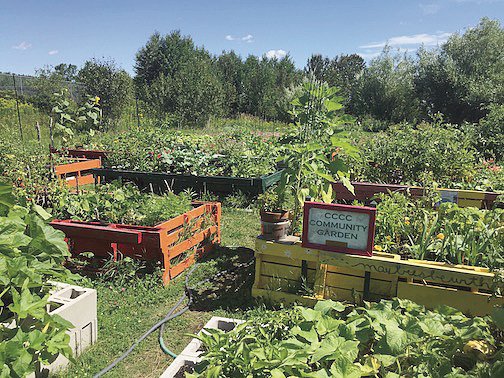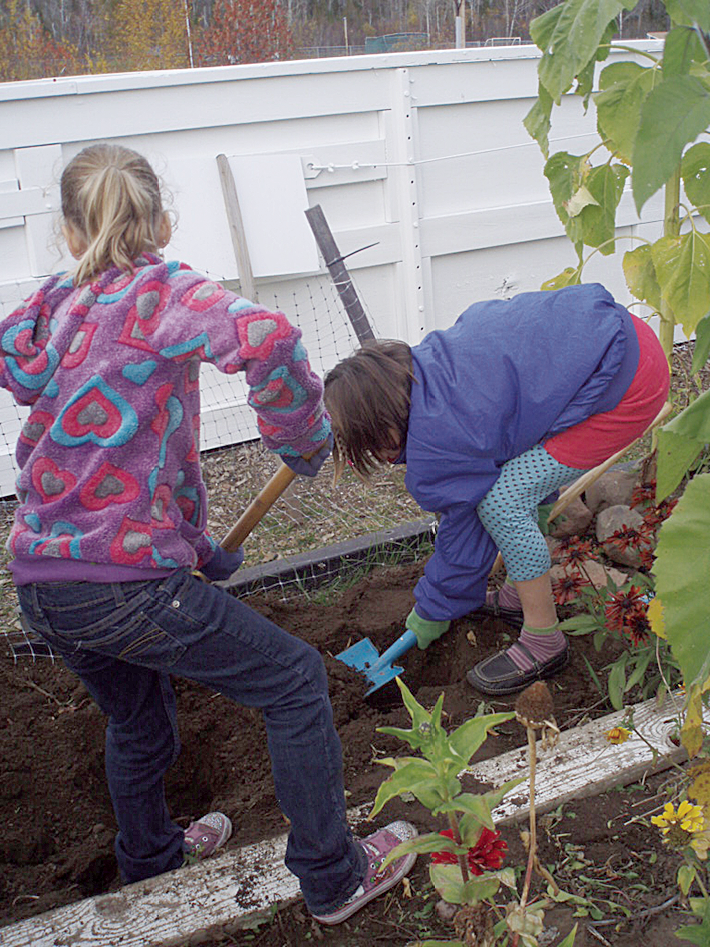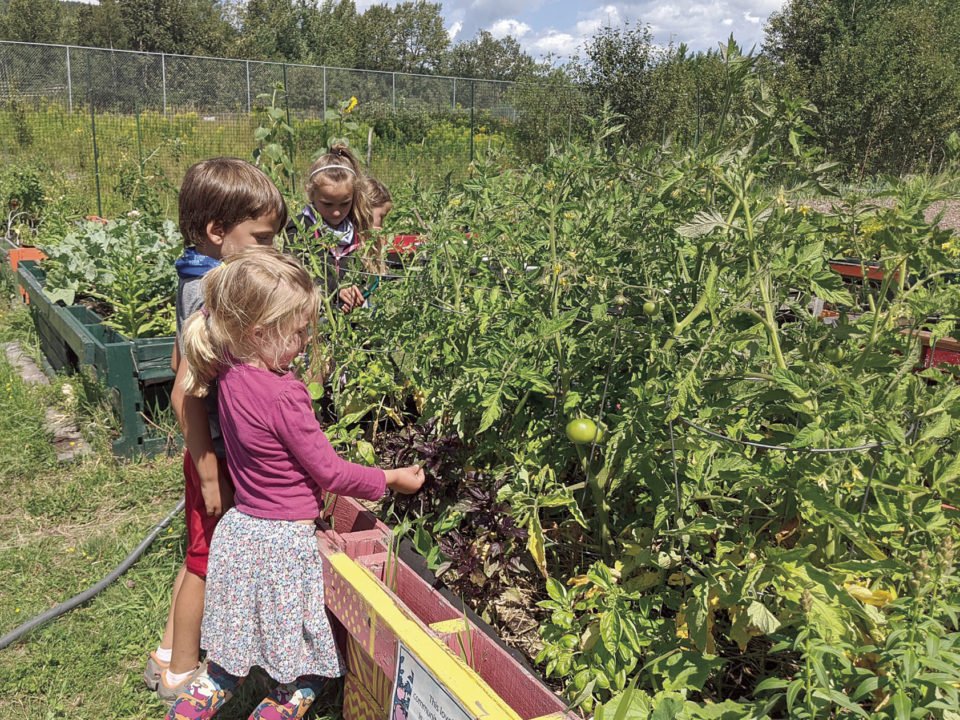In Cook County, with short growing seasons and challenging soil types, gardens grow with much love and care. While gardening is a lot of work, the satisfaction of bringing your own vegetables to the dinner table is well worth the effort. But for beginner gardeners, starting a garden for the first time can be a daunting task. How do you know if you have the right kind of soil? When is a good time to plant? And what grows well so far north? Diane Booth, director of Cook County Extension, shared tips and resources to help gardeners in the area plant and grow a fantastic garden, even if you’ve never tried gardening before.
The first step to starting a garden is determining the right place to plant your garden. Garden plots need to receive at least eight hours of sunlight a day, and should be far away from trees or large shrubs, since their root systems will compete with your garden for nutrients. Additionally, garden plots should be relatively flat. If flat land is not available on your property, terracing (whether in the ground or with raised beds) can do the trick. It’s also what’s underground that will determine whether you have a good plot for a garden. First-time gardeners should take soil samples to determine what kind of soil they have, and if they have enough of it. For in-ground gardening, the soil should be at least 12-18 inches deep.
“Cook County is notorious for having either beach rock and gravel for soil, or heavy clay,” Booth said. “If you have just beach gravel, it would be best to build raised beds at least 18 inches deep for growing vegetables.”
Soil tests that give a report of soil quality, including texture and pH, are available through the University of Minnesota Soil Testing Laboratory. The Lawn and Garden testing form can be found in person at the Cook County Extension office, or at: soiltest.cfans.umn.edu. The result of the test will determine whether there is proper soil to plant in the ground, or whether raised beds are a better option. Even for those with deep enough soil to plant in-ground, some along the North Shore opt for raised beds due to the difficulty of working with clay soil.
“You can make it work with clay, but it’s a lot of work,” Booth said. “Raised beds are probably easier for beginner gardeners. You can determine the exact soil for what you want to grow. The soil heats up earlier in the spring and has better drainage. You don’t have to till to prepare the soil, and raised beds can be temporary if you are renting your home.”

If raised beds are the route you decide to go, the soil in the beds should be at least 18 inches deep to successfully grow root vegetables. Raised beds can be constructed out of all sorts of materials including straw bales, cement blocks, corrugated metal, free pallets, or even rocks. (Just avoid reclaimed wood that you don’t know the history of, as it may have been stained with substances you don’t want in your soil.) Once your bed is constructed, it can be filled with soil, though Booth said to be careful about bringing in soil from outside of the area as it may contain jumping worms, a potentially devastating invasive species that has not been seen in Cook County yet.
Another step that can seem daunting for beginners is deciding which vegetables to plant. In Cook County, which has different microclimates and hardiness zones, gardeners have to take their particular location into account when deciding what to grow. Along Lake Superior, where summers are cooler, cool season crops like spinach, lettuces, radishes, and peas tend to do well. Farther inland from the lake, warm season crops like tomatoes, cucumbers, peppers, and beans can be planted. If you live along the lake and want to plant warm season crops, a small greenhouse or season extenders can help warm the area where you’re planting. For those considering what to plant, the Extension office offers a pamphlet called “Vegetable Varieties for Northern Minnesota.” Everything in the pamphlet has been trialed in Cook County for at least three years, and it also includes a directory of places to purchase seeds.
Whether to purchase seeds or transplant seedlings is another point to consider: due to the short growing season in Northern Minnesota, most gardeners who plant from seeds start planting and growing indoors, with indoor seed planting happening any time from February through early May. (Cook County Extension offers a list of when each seed type needs to be started indoors.) Seedlings started indoors are then “hardened,” or exposed to the elements bit by bit until they are strong enough to endure outdoor conditions. For those who haven’t started seeds indoors this spring, buying seedlings to transplant into your garden will help you make the most of the 2021 growing season. Either way, a soil thermometer will help you determine whether your garden is ready for planting: the soil should be at least 50-65 degrees F for cool season crops, and 65-85 degrees F for warm season crops.
As anyone who has ever tried gardening knows, preparing and planting your garden is just the beginning: keeping your plants alive for the rest of the summer is the other half of the story. Gardens need to be protected from threats including deer and bugs. With a small garden, fencing high enough to stop a deer from leaning over and eating your vegetables will protect them. For larger gardens, however, deer may attempt to jump the fence, in which case having fencing 9 feet tall will deter them from jumping. For other pests, lightweight fabric like Reeman or Agribon can be placed over your vegetables for the entire planting season, which will keep away flea beetles.

“Cutworms can be devastating,” Booth said. “All transplants that are put into the vegetable garden should have a 2-3-inch layer of newspaper wrapped around the transplant, 1 inch into the soil and at least 1 inch above the soil. This is an easy way to keep cutworms from cutting off your tender transplants. Beans, which are usually direct seeded, you either have to plant before and/or after the cutworms are out. It is good to purchase enough seed for several sowings in case you have a bad bout with cutworms.”
Early on in the season, your garden will need frequent, light weeding and watering. Frequent early weeding helps get rid of weeds before they can become established, and light watering keeps the soil moist without washing away delicate seedlings. As your plants become more established, they can be watered less frequently with more water per watering. Raised beds need to be watered more thoroughly since they drain easier.
“Put a thin layer of straw or light mulch over your seeds to prevent them from drying out,” Booth said. “You will want to add 1-2 inches of composted manure or other compost products to the top of your entire area where you are growing vegetables. Do not incorporate this into the soil. You want it to slowly release nutrients over time, not all at once. Additionally, you will need to side dress your vegetables with a higher N-P-K than compost to make sure they are receiving enough nutrients when growing a lot of greens, starting to flower and beginning to fruit.” (N-P-K is the ratio of the nutrients nitrogen, phosphorous and potassium.)
Even with the best preparation, all gardeners experience failure at some point. Luckily, the Extension office offers many free resources that can be checked out from their library. A guide on planting a vegetable garden can be found online at: extension.umn.edu/planting-and-growing-guides/planting-vegetable-garden.
Gardeners can also contact Diane Booth at 218-387-3015 or diane.booth@co.cook.mn.us.
“Ask long-time vegetable gardeners in Cook County any questions you may have as they are happy to share the knowledge they have gained over their many years of gardening,” she said.




